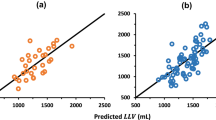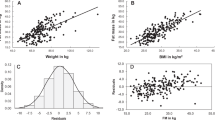Abstract
Background: Lean bodyweight (LBW) has been recommended for scaling drug doses. However, the current methods for predicting LBW are inconsistent at extremes of size and could be misleading with respect to interpreting weight-based regimens.
Objective: The objective of the present study was to develop a semi-mechanistic model to predict fat-free mass (FFM) from subject characteristics in a population that includes extremes of size. FFM is considered to closely approximate LBW. There are several reference methods for assessing FFM, whereas there are no reference standards for LBW.
Patients and methods: A total of 373 patients (168 male, 205 female) were included in the study. These data arose from two populations. Population A (index dataset) contained anthropometric characteristics, FFM estimated by dual-energy x-ray absorptiometry (DXA — a reference method) and bioelectrical impedance analysis (BIA) data. Population B (test dataset) contained the same anthropometric measures and FFM data as population A, but excluded BIA data. The patients in population A had a wide range of age (18–82 years), bodyweight (40.7–216.5kg) and BMI values (17.1–69.9 kg/m2). Patients in population B had BMI values of 18.7–38.4 kg/m2. A two-stage semi-mechanistic model to predict FFM was developed from the demographics from population A. For stage 1 a model was developed to predict impedance and for stage 2 a model that incorporated predicted impedance was used to predict FFM. These two models were combined to provide an overall model to predict FFM from patient characteristics. The developed model for FFM was externally evaluated by predicting into population B.
Results: The semi-mechanistic model to predict impedance incorporated sex, height and bodyweight. The developed model provides a good predictor of impedance for both males and females (r2 = 0.78, mean error [ME] = 2.30 × 10−3, root mean square error [RMSE] = 51.56 [approximately 10% of mean]). The final model for FFM incorporated sex, height and bodyweight. The developed model for FFM provided good predictive performance for both males and females (r2 = 0.93, ME = −0.77, RMSE = 3.33 [approximately 6% of mean]). In addition, the model accurately predicted the FFM of subjects in population B (r2 = 0.85, ME = −0.04, RMSE = 4.39 [approximately 7% of mean]).
Conclusions: A semi-mechanistic model has been developed to predict FFM (and therefore LBW) from easily accessible patient characteristics. This model has been prospectively evaluated and shown to have good predictive performance.











Similar content being viewed by others
References
Kopelman PG. Obesity as a medical problem. Nature 2000; 404(6778): 635–43
Green B, Duffull SB. What is the best size descriptor to use for pharmacokinetic studies in the obese? Br J Clin Pharmacol 2004; 58(2): 119–33
Cheymol G. Effects of obesity on pharmacokinetics implications for drug therapy. Clin Pharmacokinet 2000; 39(3): 215–31
Green B, Duffull SB. Development of a dosing strategy for enoxaparin in obese patients. Br J Clin Pharmacol 2002; 56: 96–103
Sarubbi Jr FA, Hull JH. Amikacin serum concentrations: prediction of levels and dosage guidelines. Ann Intern Med 1978; 89(5 Pt 1): 612–8
Wulfsohn NL. Succinylcholine dosage based on lean body mass. Can Anaesth Soc J 1972; 19(4): 360–72
Green B, Duffull SB. Caution when lean body weight is used as a size descriptor for obese subjects. Clin Pharmacol Ther 2002; 72(6): 743–4
Morgan DJ, Bray KM. Lean body mass as a predictor of drug dosage: implications for drug therapy. Clin Pharmacokinet 1994; 26(4): 292–307
Duffull SB, Dooley MJ, Green B, et al. A standard weight descriptor for dose adjustment in the obese patient: what is the best size descriptor to use for pharmacokinetic studies in the obese? Clin Pharmacokinet 2004; 43(15): 1167–78
Roche AF, Heymsfield SB, Lohman TG, editors. Human body composition. Champaign (IL): Human Kinetics, 1996
Pi-Sunyer FX. Obesity: criteria and classification. Proc Nutr Soc 2000; 59(4): 505–9
Bioelectrical impedance analysis in body composition measurement. Bethesda (MD): National Institutes of Health, Public Health Service, 1994 Dec 12–14
Liedtke RJ. Fundamentals of bioelectrical impedance analysis [online]. Available from URL: http://www.rjlsystems.com/docs/bia_info/fundamentals [Accessed 2005 Jul 3]
Ellis KJ. Human body composition: in vivo methods. Physiol Rev 2000; 80(2): 649–80
Stewart AD, Hannan WJ. Prediction of fat and fat-free mass in male athletes using dual x-ray absorptiometry as the reference method. J Sports Sci 2000; 18(4): 263–74
Pietrobelli A, Formica C, Wang Z, et al. Dual-energy x-ray absorptiometry body composition model: review of physical concepts. Am J Physiol 1996; 271(6 Pt 1): E941–51
Blake G, Fogelman I. Technical principles of dual energy x-ray absorptiometry. Semin Nucl Med 1997; 37: 210–28
Heymsfield SB, Smith R, Aulet M, et al. Appendicular skeletal muscle mass: measurement by dual-photon absorptiometry. Am J Clin Nutr 1990; 52(2): 214–8
Beal SL, Sheiner LB. NONMEM user’s guide (Pt I). San Francisco (CA): University of California, 1992
Sheiner LB, Beal SL. Some suggestions for measuring predictive performance. J Pharmacokinet Biopharm 1981; 9(4): 503–12
Akaike H. A new look at the statistical model identification. IEEE Trans Automat Contr 1974; 19: 716–23
Lukaski HC, Johnson PE, Bolonchuk WW, et al. Assessment of fat-free mass using bioelectrical impedance measurements of the human body. Am J Clin Nutr 1985; 41(4): 810–7
Lohman TG. Advances in body composition assessment. Champaign (IL): Human Kinetics, 1992
James W. Research on obesity. London: Her Majesty’s Stationery Office, 1976
Womersley J, Boddy K, King PC, et al. A comparison of the fat-free mass of young adults estimated by anthropometry, body density and total body potassium content. Clin Sci 1972; 43(3): 469–75
Hume R, Weyers E. Relationship between total body water and surface area in normal and obese subjects. J Clin Pathol 1971; 24(3): 234–8
Boddy K, King PC, Hume R, et al. The relation of total body potassium to height, weight, and age in normal adults. J Clin Pathol 1972; 25(6): 512–7
Anon. Obesity: preventing and managing the global epidemic. Report of a WHO consultation on obesity. Geneva: World Health Organization, 1997 Jun 3–5
Black D, James WPT, Besser GM, et al. Obesity: a report of the Royal College of Physicians. J R Coll Physicians Lond 1983; 17(1): 5–65
Garrow JS, Webster J. Quetelet’s index (W/H2) as a measure of fatness. Int J Obes 1985; 9(2): 147–53
Slaughter MH, Lohman TG, Boileau RA, et al. Skinfold equations for estimation of body fatness in children and youth. Hum Biol 1988; 60(5): 709–23
Malina RM, Katzmarzyk PT. Validity of the body mass index as an indicator of the risk and presence of overweight in adolescents. Am J Clin Nutr 1999; 70(1): 131–6S
Sarria A, Garcia-Llop LA, Moreno LA, et al. Skinfold thickness measurements are better predictors of body fat percentage than body mass index in male Spanish children and adolescents. Eur J Clin Nutr 1998; 52(8): 573–6
Gray DS, Bray GA, Bauer M, et al. Skinfold thickness measurements in obese subjects. Am J Clin Nutr 1990; 51(4): 571–7
Kyle UG, Genton L, Karsegard L, et al. Single prediction equation for bioelectrical impedance analysis in adults aged 20–94 years. Nutrition 2001; 17(3): 248–53
Lukaski HC, Bolonchuk WW, Hall CB, et al. Validation of tetrapolar bioelectrical impedance method to assess human body composition. J Appl Physiol 1986; 60(4): 1327–32
Thomsen TK, Jensen VJ, Henriksen MG. In vivo measurement of human body composition by dual-energy x-ray absorptiometry (DXA). Eur J Surg 1998; 164(2): 133–7
Vettorazzi C, Smits E, Solomons NW. The interobserver reproducibility of bioelectrical impedance analysis measurements in infants and toddlers. J Pediatr Gastroenterol Nutr 1994; 19(3): 277–82
Acknowledgements
We would like to acknowledge Christine Staatz, PhD, for her assistance in conducting the study. S. Janmahasatian was funded by a scholarship from the Australian Agency for International Development (AusAID). The authors have no potential conflicts of interest that are directly relevant to the contents of this study.
Author information
Authors and Affiliations
Corresponding author
Rights and permissions
About this article
Cite this article
Janmahasatian, S., Duffull, S.B., Ash, S. et al. Quantification of Lean Bodyweight. Clin Pharmacokinet 44, 1051–1065 (2005). https://doi.org/10.2165/00003088-200544100-00004
Published:
Issue Date:
DOI: https://doi.org/10.2165/00003088-200544100-00004




